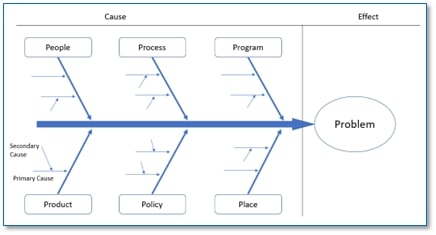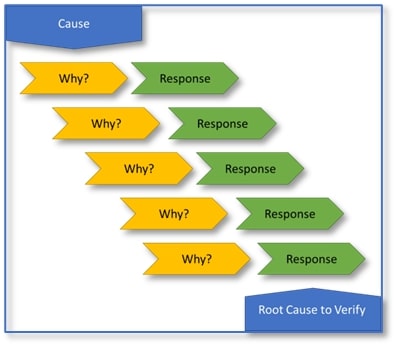Written by Contributing Columnist: David Larsen, PSP, PMP, LSSMBB
Problems are frequently encountered by leaders, teams, and individual contributors. Problems can be viewed as opportunities to improve. At times, leaders can be treated as dumping grounds for other people’s problems.
Let’s discuss a collaborative approach to identify a problem, determine the potential root causes of a problem, and the actions to take to verify and validate root causes and drive effective problem solving. This approach can be applied to a one-off issue or a reoccurring problem that can no longer be ignored.
Identify the Problem
A key insight to the pursuit of root causation is knowing how the problem is defined, which determines whether it is solved. It is important to evaluate the situation so that the focus is on the problem, not on the symptoms. Consider the approach to defining the problem statement in three categories: the current state, gap(s), and the future state. Then facilitate a conversation with the team to understand the current state and identify the symptoms.
The symptoms can also be equated to the gaps or the pain points the team is experiencing within the process. Establish with the team the timeframe or trend for the problem, describing when and where was the issue first observed and the kind of trend is issue is following. Discuss the impact the problem is causing on the process; the impact(s) will likely be quantifiable in terms of cost, time, or quality. Learn the importance the process has to the team, department, or organization; the goal is to gain a better understanding of the urgency to arrive at an improvement to the problem.
The following questions are starting points to discuss with your team to gain insights and formulate the problem statement.
- What is the problem that needs to be solved?
- Why is it a problem? (highlight the pain)
- Where is the problem observed?
- Who is impacted?
- When was the problem first observed?
- How is the problem observed? (symptoms)
- How often is the problem observed? (error rate, magnitude, trend)
Understanding the Causes
Equipped with a clear problem statement, the next step is to identify and analyze potential root causes. An effective problem-solving tool is the Cause-and-Effect diagram. The Cause-and-Effect diagram became first known within industry as the Ishikawa or the Fishbone diagram because it has an appearance much like the skeleton of a fish. The diagram was first made popular by Dr. Kaoru Ishikawa in the late 1970s and early 1980s.
The diagram (shown above) can be drawn in-person or virtually using your preferred application. The effect or problem is written to the right-side of the workspace. A horizontal line divides the workspace to the left into two equal parts. Popular categories to theme the contributing causes include 6Ps (Policy, Process, People, Procedure, Program and Product) or 6Ms (Measurement, Materials, Method, Mother Nature, Manpower, Machine).
Keep in mind, these categories are not rigid and can be a starting point and themed after brainstorming with the team. The categories become the branches off the horizontal line leading to the effect on the right-side of the workspace. The Cause-and-Effect diagram is best used to list out as many possible causes, secondary causes, and tertiary causes, until the team runs out of ideas. The goal to developing this diagram is to facilitate a fast-moving exercise so that the team can solicit as many ideas in as short period as possible.
A complimentary analysis method to the Cause-and-Effect diagram is the 5-Why analysis. The 5-Why analysis supports the team moving beyond causes or symptoms to understand the root cause of a problem. By repeatedly asking the question “Why” (five is a general rule of thumb), you can peel away the layers of symptoms which can lead to the root cause of a problem. Often, the apparent reason for a problem will lead to another question. Although this technique is called “5 Whys,” you may find that you will need to ask the question fewer or more times than five before you find the issue related to a problem.
Go, See, and Validate
The results of the Cause-and-Effect diagram and 5-Why analysis show the potential root causes, or hypotheses, as the diagrams are created based upon experiences of the team and not data. The next steps are for the identified root causes to be validated to determine if the hypotheses are true or false. The activities to validate the root causes include performing a Gemba walk to observe the process, a data collection plan, and analysis.
If your organization does not have system data in place, that’s okay. The data collection plan can include scope for the team performing the process to manually collect data for a timeframe to support root cause validation. It’s likely to be discovered that there are multiple causes to a problem’s existence, with individual root causes contributing to a percentage of the problem. The goal for validation is to have confirmation of root causes before applying resources to countermeasure and correct the problem. Once the root causes are validated and identified, improvement efforts can be prioritized based upon the contribution each root cause has to the problem.
Monitoring and Sustaining
Defining the problem, collaborating with team members performing the process, and implementing solutions are the greatest efforts to continuous improvement initiatives. Once the solutions are in place and active, the challenge shifts to confirming the solutions have solved the problem. This involves developing a control plan with the team for data collection and monitoring the process improvements. This control plan is vital to confirm the target problem has been solved or can serve as a signal to continue the investigation.
Leaders, teams, and individual contributors have a role and responsibility to develop and maintain an organizational culture of continuous improvement. Problems are opportunities to improve a process and workflow. The Cause-and-Effect diagram and 5-Why analysis can support visualizing what can be perceived as an overwhelming problem and identify approachable avenues to pursue problem solving.
Bio:
David Larsen is a certified Planning and Scheduling Professional, certified Project Management Professional (PMP ®), Lean Six Sigma Master Black Belt, author and podcast guest with more than 20 years of experience in human resources, healthcare, manufacturing, quality and process improvement. Success comes from challenging the current state and asking tough questions. He coaches and develops others while practicing servant leadership; striving to establish collaborative and trustful relationships with individuals at all levels. He has experience leading large and complex cross functional project teams, coaching team members, and facilitating for success. A principle that he believes to be fundamental is learning to take every challenge as either a gateway to success or an opportunity to learn.
Social Media:





